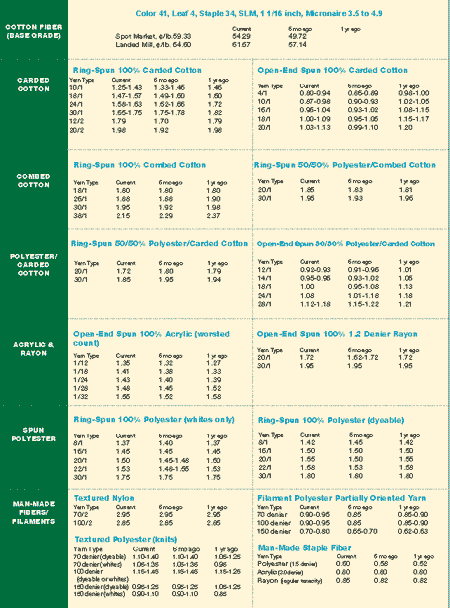Yarn MarketBy J. Karl Rudy, Technical Editor

Open-End Yarn Production DecreasingInitial reports from respondents in the cotton field
indicate that, while the crop this year will be large, the quality of the crop has deteriorated.
Drought conditions have ad-versely affected staple length, causing the fiber to be shorter.
Micronaire has also been hit. Rain late in the season will cause a spotted condition that will also
affect unharvested crop quality. Classing for the season has started, with about 10 percent of the
crop checked. Of course, when the irrigated crop starts coming in, crop quality will
improve.Spinners report additional movement in open-end (OE) spinning to reduce overall weekly
production of over a million pounds through closings, mergers and buyouts. They also say that
weavers in vertical operations have begun buying their OE cotton needs or replacing them with
ring-spun yarns, accounting for another million pounds or so weekly. As a result, spinners are
expecting early relief in the pricing situation that has plagued them for so long. Cotton prices
continue to move up, though, which puts a further strain on an already depressed bottom
line.Several respondents to the Yarn Market commented on this situation by saying, Pricing will
improve in 2001. It has to or retailers will not be able to purchase domestic yarn spinners will be
out of business. The follow-up comment to this is something to the effect that retailers care only
about their own bottom line, especially the large-scale merchandisers. Another spinner said, With
cotton up about 13 cents, pricing will have to go up!Volume for most OE spinners continues to be
good but they expect further improvement during the first quarter of 2001. Now, how about that
improvements in both pricing AND volume in 2001!One spinner, reminiscing about the good old days,
said, When I first started , a 10/1 cotton yarn sold for 56 cents a pound. Cotton was a constant 25
or 26 cents. And this was all ring-spun yarn. Some of us can remember when cotton sold for less
than 20 cents a pound and, if you go back far enough, you could buy a cord of wood for $1. But who
wants to go back to outdoor privies and no running waterRing-spun yarn markets are reported to be
very, very, very strong. Others confirm this market is very tight, as it has been for months. Mills
are running wide open and shipping all they make. On occasion they ship more than they make. That
should tell you something!Weaving has slowed in recent weeks, as confirmed by a weaver respondent.
Optimism still prevails, however, and weavers expect the slow-down to be of short duration.
Apparently, the problem is predominately with the apparel side of the market. Could this be due to
retail inventory, mentioned a few months ago by a spinner Last month, Yarn Mar-ket reported a
texturizers comment about a rumor to this effect concerning bottom-weight goods. For your
information this weaver is in bottom-weight apparel production.Synthetic markets are awful, as one
spinner put it. He also said, No area we sell would I consider robust all are weak! We hear it
might be due to inventory at retail but I dont really know. Even home furnishings, which is
normally pretty strong, suddenly became weak. We have curtailed from six- to five-day operations to
control inventory. Im surprised at the markets being so quiet it usually doesnt happen during an
election year. This will be a weak quarter, but I expect it will pick up by mid-January. He also
commented that he was optimistic about the Caribbean Basin Initiative but was discouraged with the
small number of attendees from that area at a recent conference.Trade Versus Fair TradeThe trade
agreement with China is on everyones mind not from the sense of whether we should have one, because
most consider it a done deal, but, rather, whether it will be a fair trade agreement, one that will
have enough safeguards to prevent abuses, with penalties severe enough to discourage unfair
practices. Farmers are, of course, most supportive of the agreement, but we need to remind our
politicians that agriculture is not the only industry concerned here. Even so fair is fair
regardless of the industry involved.To leave you with a thought for the day With the price of gas
running $25 for a tank, will consumers buy a $25 shirt they dont need just because they like the
color

November 2000




